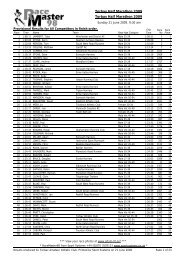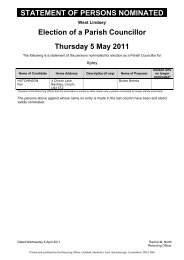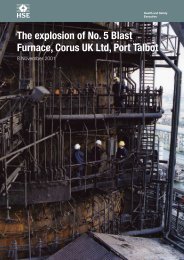A cArbon cApture And storAge network for yorkshire And humber
A cArbon cApture And storAge network for yorkshire And humber
A cArbon cApture And storAge network for yorkshire And humber
You also want an ePaper? Increase the reach of your titles
YUMPU automatically turns print PDFs into web optimized ePapers that Google loves.
Figure 5.1 Carbon dioxide phase diagram<br />
Pressure, bar<br />
73.0<br />
5.11<br />
1<br />
Solid<br />
If the critical pressure were to increase <strong>for</strong><br />
the mixture, or the contaminant change the<br />
phase to vapour, then the system hydraulics<br />
will change.<br />
The following figure shows one example<br />
as an illustration. Figure 5.2 and figure 5.3<br />
shows the deviation from pure CO2 caused<br />
by the presence of nitrogen. In all cases<br />
pure CO2 is one, the deviations are from this<br />
baseline, <strong>for</strong> example a data point of<br />
1.2 <strong>for</strong> density shows that the mixture is<br />
20% denser than pure CO2.<br />
As can be seen from the chart a 4%<br />
concentration of nitrogen imposes an<br />
11% increase in pressure drop. The critical<br />
points <strong>for</strong> this mixture become 26.6°C and<br />
82.3 bar.<br />
Similar effects can be seen considering the<br />
other contaminants. Typically the common<br />
contaminants generally correlate to a +/-<br />
20% deviation in most properties at around<br />
5% mol in a binary mixture.<br />
For critical temperature and pressure the<br />
general pattern is that an increase in the<br />
percentage of a contaminant increases<br />
the critical pressure and decreases the<br />
critical temperature. There are three notable<br />
exceptions; H2S, SO2 and NO2 increase<br />
both critical temperature and pressure.<br />
Carbon Capture and Storage Network 15<br />
Liquid<br />
Temperature, ˚C<br />
Gas<br />
-78.5 -56.4 31.1<br />
Supercritical<br />
Changes in the critical point represent<br />
changes in the phase envelope. As the<br />
critical point shifts with contaminant<br />
concentration it could impact on the<br />
operating point or envelope of the main<br />
system. Introducing a high contaminant<br />
source could push the phase envelope past<br />
the operating point of the <strong>network</strong> and may<br />
cause a change in phase. Figure 5.4 shows<br />
the change in phase envelope <strong>for</strong> a CO2<br />
– nitrogen mixture with increasing levels<br />
of nitrogen.<br />
Consider point A on the graph as the<br />
optimum operating point of a pipeline<br />
normally operating in a 4% nitrogen in CO2<br />
mixture, just below critical temperature<br />
but with a 10%, in this case 8 bar margin<br />
on pressure. An increase of 2% to a 6%<br />
contamination level reduces the margin<br />
above critical pressure, but reduces<br />
the critical temperature, the fluid is<br />
now supercritical.<br />
To avoid these changes in physical<br />
properties within a pipeline the variance<br />
that can occur must be controlled. To this<br />
extent an entry specification provides a<br />
design point around which the pipeline can<br />
be designed as to eliminate phase changes<br />
within the operating <strong>network</strong>.<br />
5.6 TECHNICAL IMpACT<br />
Key to a pipeline’s design is not only the<br />
physical constituents of the fluid but also its<br />
condition. The pressure and temperature<br />
<strong>for</strong> entry must be kept at a near uni<strong>for</strong>m<br />
level to avoid local pressure problems<br />
such as two phase flow or changes in<br />
bulk temperature. There<strong>for</strong>e a specification<br />
must include a minimum pressure and a<br />
maximum temperature. Generally given<br />
the critical point, temperature is limited to<br />
a condition that it must be less than 30°C.<br />
For pressure the critical point should be<br />
avoided, there<strong>for</strong>e a minimum pressure of<br />
100 bar would be acceptable, this gives a<br />
30 bar margin from the critical point to allow<br />
<strong>for</strong> pressure drop within the system.<br />
For a <strong>network</strong> that has to deal with<br />
multiple individual sources the design must<br />
accommodate all reasonable variations<br />
of flow that may occur. To achieve this,<br />
a <strong>network</strong> specification is required to<br />
limit the variability of the fluid properties<br />
to a reasonable level so that equipment<br />
design has a narrow range of key physical<br />
properties as possible. It is generally<br />
accepted that a design factor of 10% is<br />
applied to process equipment based on<br />
the averages of the streams involved. If<br />
the variation in properties is wide then the<br />
overall design range may be excessive,<br />
a 20% variation in physical properties in

















